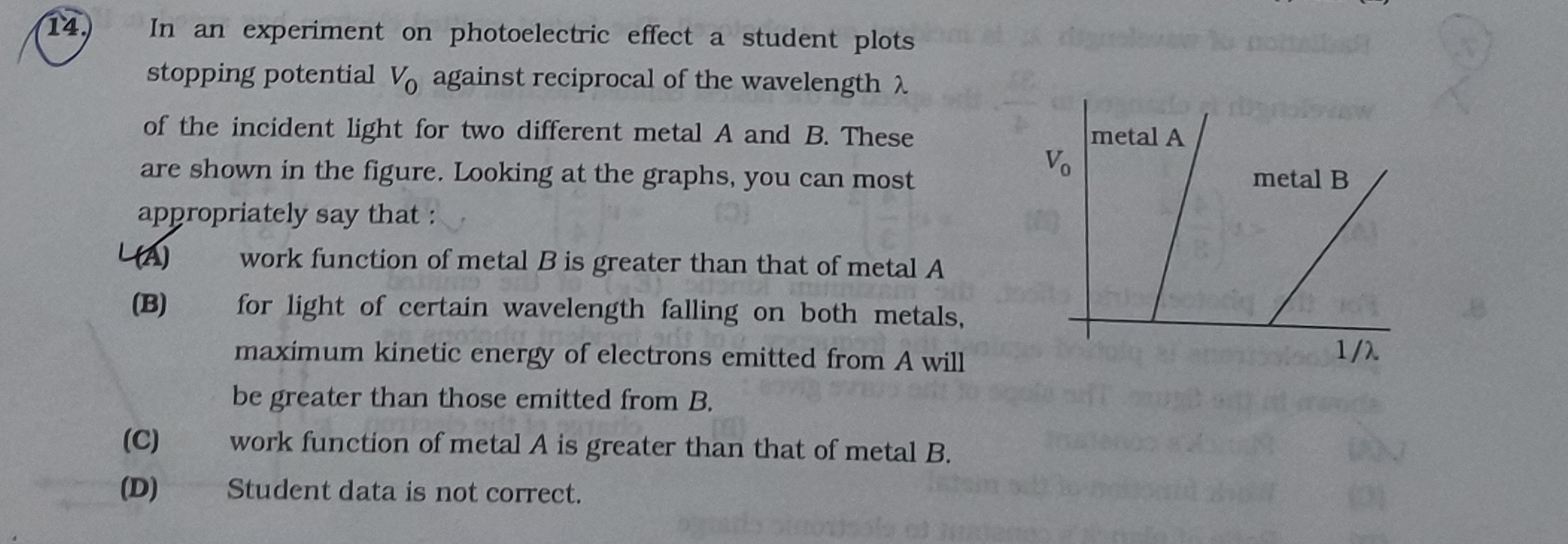Question
Question: In an experiment on photoelectric effect a student plots stopping potential $V_0$ against reciprocal...
In an experiment on photoelectric effect a student plots stopping potential V0 against reciprocal of the wavelength λ of the incident light for two different metal A and B. These are shown in the figure. Looking at the graphs, you can most appropriately say that :

work function of metal B is greater than that of metal A
for light of certain wavelength falling on both metals, maximum kinetic energy of electrons emitted from A will be greater than those emitted from B.
work function of metal A is greater than that of metal B.
Student data is not correct.
work function of metal B is greater than that of metal A
Solution
The relationship between stopping potential (V0), work function (ϕ), and the reciprocal of wavelength (1/λ) in the photoelectric effect is given by the equation: V0=ehc(λ1)−eϕ This equation is in the form of a straight line (y=mx+c), where y=V0, x=1/λ, the slope m=hc/e, and the y-intercept c=−ϕ/e.
From the graph, we observe that the lines for metals A and B are parallel, indicating they have the same slope (hc/e), which is consistent with the theory.
The y-intercept (−ϕ/e) is directly related to the work function. A more negative y-intercept corresponds to a larger work function. Alternatively, the threshold wavelength (λth) for photoelectric emission is given by λth=hc/ϕ. When the stopping potential is zero (V0=0), the incident photon energy is just enough to overcome the work function, i.e., hν=ϕ, or hc/λ=ϕ. Thus, 1/λth=ϕ/hc.
Looking at the graph, the x-intercept (where V0=0) represents the threshold value of 1/λ. For metal A, the x-intercept is at a smaller value of 1/λ compared to metal B. Let's denote these as (1/λ)th,A and (1/λ)th,B. So, (1/λ)th,A<(1/λ)th,B.
Since ϕ=hc(1/λth), we have: ϕA=hc(1/λ)th,A ϕB=hc(1/λ)th,B
As (1/λ)th,A<(1/λ)th,B, it directly implies that ϕA<ϕB. Therefore, the work function of metal B is greater than that of metal A. This makes option (A) correct.
Option (B) states that for a certain wavelength, the maximum kinetic energy of electrons emitted from A will be greater than those from B. The maximum kinetic energy is given by Kmax=hν−ϕ. For a given frequency ν (or wavelength λ), hν is the same. Since ϕA<ϕB, then hν−ϕA>hν−ϕB, meaning Kmax,A>Kmax,B. This statement is also true.
However, the question asks for the "most appropriately" say. The difference in work functions is a fundamental property of the metals and is directly represented by the threshold behavior shown in the graph. Option (A) describes this fundamental difference. Option (B) describes a consequence of this difference under specific incident light conditions. Therefore, stating the difference in work functions is a more direct and appropriate conclusion from the graph itself.
Option (C) is incorrect because ϕA<ϕB. Option (D) is incorrect because the graph is consistent with the photoelectric effect theory.
